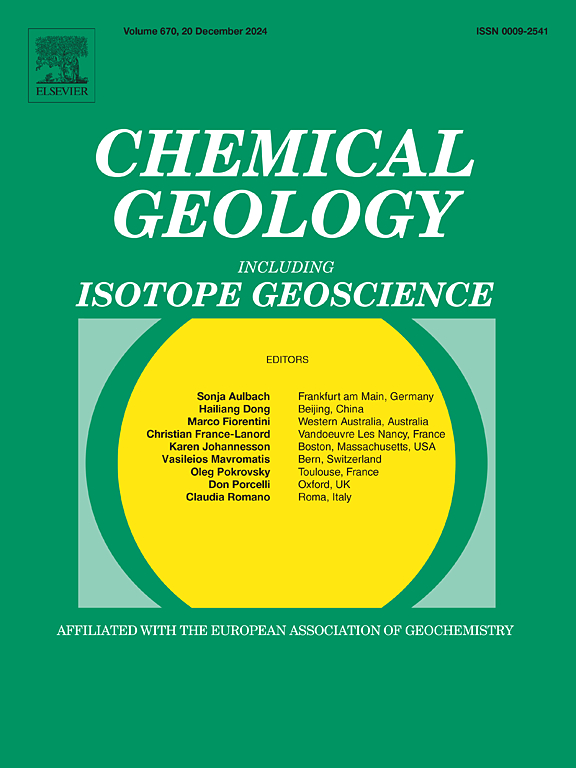A modified Rock-Eval approach to track organics in (bio)carbonates
IF 3.6
2区 地球科学
Q1 GEOCHEMISTRY & GEOPHYSICS
引用次数: 0
Abstract
Biominerals, notably carbonates, serve as valuable biosignatures for identifying past or present life in terrestrial environments. However, distinguishing between biogenic and abiotic minerals usually required multiple high-resolution techniques, challenging their application for the in situ search for extraterrestrial life in space missions with limited analytical capabilities. This study investigated the potential of gas profiles (i.e., carbon dioxide CO, carbon monoxide CO, and sulfur dioxide SO) generated by Rock-Eval purified air combustion (in the range 50–700 °C) and dinitrogen pyrolysis (in the range 700–1000 °C) of 66 natural and laboratory carbonates to detect organics associated with these carbonate minerals that could hold clues to their origin (either abiotic or biogenic) and formation process. For bio-related and organo-carbonates containing Ca and Ca/Mg, CO and SO emissions detected below 700 °C were the product of combustion and associated thermal cracking of organic compounds initially coating mineral grain surfaces, while those detected above 700 °C, during and after the thermal decomposition of Ca- and Ca/Mg-carbonates, were derived from the thermal cracking of organic compounds trapped within carbonate crystals, suggesting the carbonates formed in the presence of organic compounds of biological or abiotic origin. For hydrated Mg-carbonates, the interpretation is more challenging due to multiple phase transitions that overlap with the combustion and thermal cracking of surface and trapped organic compounds in the same temperature range. Overall, this study highlights the potential of our modified Rock-Eval approach as a valuable technique for rapidly identifying and characterizing potential biosignatures in Ca- and Ca/Mg-carbonate at the bulk sample scale, an approach that can be reasonably implemented on in situ space instruments for the search for present or past extraterrestrial life.

一种改进的岩石评价方法跟踪(生物)碳酸盐中的有机物
生物矿物,特别是碳酸盐,是识别陆地环境中过去或现在生命的有价值的生物特征。然而,区分生物矿物和非生物矿物通常需要多种高分辨率技术,这对分析能力有限的空间任务中对地外生命的原位搜索提出了挑战。本研究研究了66种天然和实验室碳酸盐的净化空气燃烧(50-700°C)和二氮热解(700-1000°C)产生的气体分布(即二氧化碳CO2,一氧化碳CO和二氧化硫SO2)的潜力,以检测与这些碳酸盐矿物相关的有机物,这些有机物可能为它们的起源(非生物或生物成因)和形成过程提供线索。对于含有Ca和Ca/Mg的生物相关碳酸盐和有机碳酸盐,在700°C以下检测到的CO和SO2排放是最初覆盖在矿物颗粒表面的有机化合物燃烧和相关热裂解的产物,而在700°C以上检测到的Ca-和Ca/Mg碳酸盐热分解期间和之后的排放来自于碳酸盐晶体中捕获的有机化合物的热裂解。表明碳酸盐是在生物或非生物来源的有机化合物存在下形成的。对于水合mg -碳酸盐岩,由于在同一温度范围内,表面和被捕获的有机化合物的燃烧和热裂解发生了多重相变,因此解释更具挑战性。总的来说,这项研究强调了我们改进的岩石评估方法作为一种有价值的技术的潜力,可以快速识别和表征Ca-和Ca/ mg -碳酸盐岩中潜在的生物特征,这种方法可以合理地应用于原位空间仪器上,用于寻找现在或过去的外星生命。
本文章由计算机程序翻译,如有差异,请以英文原文为准。
求助全文
约1分钟内获得全文
求助全文
来源期刊

Chemical Geology
地学-地球化学与地球物理
CiteScore
7.20
自引率
10.30%
发文量
374
审稿时长
3.6 months
期刊介绍:
Chemical Geology is an international journal that publishes original research papers on isotopic and elemental geochemistry, geochronology and cosmochemistry.
The Journal focuses on chemical processes in igneous, metamorphic, and sedimentary petrology, low- and high-temperature aqueous solutions, biogeochemistry, the environment and cosmochemistry.
Papers that are field, experimentally, or computationally based are appropriate if they are of broad international interest. The Journal generally does not publish papers that are primarily of regional or local interest, or which are primarily focused on remediation and applied geochemistry.
The Journal also welcomes innovative papers dealing with significant analytical advances that are of wide interest in the community and extend significantly beyond the scope of what would be included in the methods section of a standard research paper.
 求助内容:
求助内容: 应助结果提醒方式:
应助结果提醒方式:


